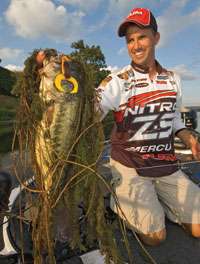
Because hollow, weedless frogs and solid plastic toads excel in shallow grass, many anglers think they are interchangeable. They are wrong. Frogs and toads are two very different lures and presentations. The question is, when do you frog and when do you toad?
Bassmaster Elite Series pro Edwin Evers of Talala, Okla., regards the toad as a subtle buzzbait that shows bass a more realistic profile than a buzzer. He opts for the toad on flat to rippled water and the buzzbait when a breeze chops the surface. A toad also gets the call when he casts to cover that bogs down a buzzbait.
Bass finder
"The toad is great search bait," Evers said. "You can cast it a mile and cover tons of water with it."
These days, Evers relies on the hyperactive Yum Money Toad when he's on a search-and-destroy mission. He rigs this bait with a 5/0 hook that has a screw-in keeper and a 3/16-ounce weight on its shank. The weight increases casting distance and forces the bait to swim belly down. A steady retrieve works best for Evers when he's fishing a toad. "I keep it going just fast enough to make those little legs kick up bubbles. The slower the better," he explained.
Key toad water for Evers includes clumpy grass flats, lily pads and emergent vegetation, such as bulrushes and waterwillows. He has also used a toad to sweep rocky banks. All these environments allow long casts that seine massive amounts of water.
Frog targets
Evers reserves hollow frogs for specific bass lairs. These are typically clumps of grass 3 to 5 feet in diameter, especially matted vegetation covered with "slimy, yellow cheese snot." Bass that hunker under such fortresses are less inclined to blast through the gunk to engulf a sputtering toad overhead.
Evers coaxes strikes by plopping a frog on the mat and working it with short scoots between pauses as long as 15 seconds. When the frog hops off the edge of the mat, Evers twitches the bait side to side for a few feet to give the bass one last opportunity. Frog master Dean Rojas also frogs specific targets but not just grass. He frequently skips his Spro Bronzeye Frog under boat docks and overhanging limbs. You can skip a toad into the same places, but you must swim it back immediately, Rojas pointed out.
"A hollow frog is more versatile than a toad because you can work it as slowly as you need to," Rojas said. Bass sometimes nail Rojas' frog with a reaction strike the instant the bait lands on target. The strike is so fast the bass must see it coming, said Rojas. It takes lightning-fast reflexes to hook these bass, which is why Rojas uses a Quantum baitcasting reel that has quick 7.3:1 Burner gears. He fills the reel with 65-pound Izorline braid. However, Rojas usually teases a feeding or aggravation bite with skillful rod maneuvers that do everything but make the frog croak. He especially likes to swap the frog from one side to the other while barely moving it forward.
Another ploy is to wiggle the rod tip on a slack line as you would with a shaky head worm, making the frog quiver in place. The soft tip on the 7-foot Quantum Dean Rojas frog rod helps him impart these subtle actions. The key is to keep the frog working in the strike zone. Then again, bass don't always want a sedate frog. When bass are aggressive,
Rojas chugs his frog along with continuous rod twitches. And, he won't hesitate to swim a toad in these instances. "You have to be willing to change," Rojas said. "A lot of times that toad-kicking action triggers a reaction strike." Even when Rojas is fishing a toad, he keeps a frog rod within easy reach. Should a bass blow up and miss a toad, Rojas cranks in and fires a frog back to the fish. Slow twitches often spark a second strike.





